on Swedish Design, AAA and AEB, EV Readiness, Kia EV6, Rice for Tires, Calm Bentley, & Fueling Vehicles
People like Swedish designs. . .AAA finds automatic emergency braking lacking. . .EV readiness around the world. . .the Kia EV6 and addressing carbon emissions. . .Using ag waste for EV tires. . . Bentley creates calm SUV. . . What people want when fueling/charging
Would You Buy a $12,474 Swedish Bicycle?
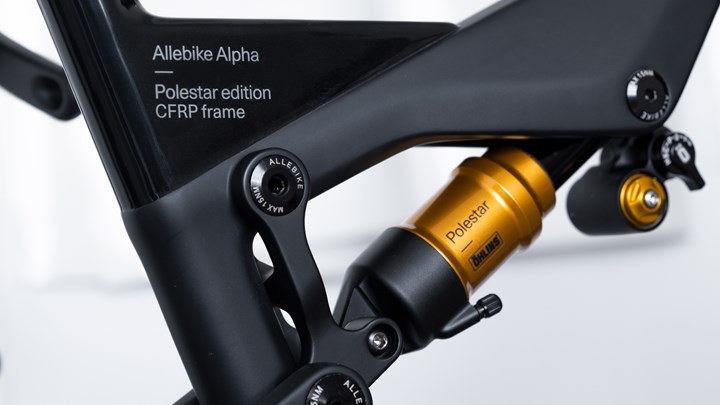
Serious engineering. Bicycle engineering, that is. (Image: Polestar)
Polestar will introduce its third vehicle next week, the Polestar 3, which unsurprisingly follows the Polestar 2. But while the Polestar 2 and the Polestar 3 are electric vehicles, they are actually the company’s first and second EVs:
The carbon-fiber bodied Polestar 1 is a 609-hp hybrid.
The Polestar 3 will feature dual motors, a range of an estimated >600 km (on the WLTP testing protocol), lidar from Luminar and processing from NVIDIA.
Production will commence in 2023.
There will be two more Polestar models (4 and 5?) by 2025. They will be all-electric, too.
Not in the Numbered Sequence
This past July Polestar introduced another vehicle, albeit one with two, not four, wheels.
It is the Allebike Alpha Polestar edition. It is a limited-edition mountain bike hand built by Allebike in Alingsås, Sweden, not far from Polestar HQ in Gothenburg, Sweden. The bike features suspension components from Öhlins, which is based in Upplands Väsby, Sweden. (See a trend of local sourcing?)
The Allebike Alpha Polestar is a limited edition of 100.
It is priced at $12,474.
Wondering about it, we checked: Sold out.
And Last Year. . .
Last year Polestar collaborated with another Swedish company, Cake, on the “Makka – Polestar edition by CAKE,” an urban electric bike. The $5,292 bike, also available on the Polestar Additionals site, also sold out.
Which goes to the point that people are clearly interested in acquiring well-designed Swedish products, which ought to make Polestar happy. Especially if those people opt for things that have four wheels, too.
>>>
AAA Tests AEB
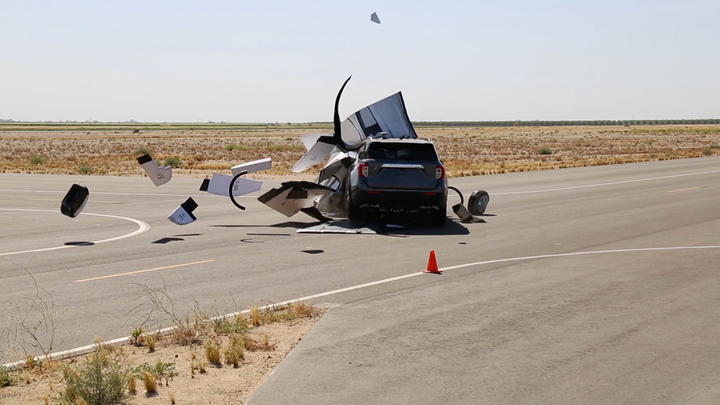
AAA found that AEB isn’t particularly useful in intersections. (Image: AAA)
Automatic Emergency Braking (AEB) can be a very good thing, especially in cases when a vehicle is traveling 30 mph and on its way to encountering the rear end of a vehicle traveling 0 mph.
AAA researchers put four 2022 model year vehicles (Chevrolet Equinox LT, Ford Explorer XLT, Honda CR-V Touring, Toyota RAV4 LE) all with their respective AEB systems to the test.
And in the 30 mph scenario the AEB systems prevented rear-end collisions 85% of the time (17 out of 20 test runs) and for the three runs when collisions occurred, the impact speed was reduced 86%.
Not So Good
Then there were runs at 40 mph.
In this case, rear-end crashes were avoided only 30% of the time (six out of 20). The impact speed was reduced by 62%.
Really Not Good
And then they ran tests at intersections: T-bones and a left turn in front of the vehicle.
As the report puts it:
“Each evaluated AEB system failed to issue an alert or provide any braking mitigation for any of the five test runs for each test scenario. In aggregate, 40 of 40 test runs involving common intersection-based scenarios resulted in impact with no speed mitigation. This finding illustrates the reality that current AEB systems are ineffective at mitigating or preventing intersection-based collision scenarios, which accounted for 2,914,220 police-reported injuries and 10,413 fatalities in the United States between 2016 and 2020. It is additionally important to note that evaluated test speeds were representative of the lower bound of posted speed limits observed when injuries and fatalities caused by intersection-based collisions typically occur.”
The researchers acknowledge that AEB was developed for rear-end collisions and that there is the opportunity to further develop the systems to mitigate problems at intersections.
But in the meantime, drive carefully.
>>>
The U.S., Japan, UAE and Thailand?
Tesla. General Motors. Ford.
One might imagine that as the U.S. is home to those companies, the nation would have a leadership position in global electric vehicle deployment.
Nope.
The Arthur D. Little “Global Electric Readiness Index—GEMRIX 2022” puts countries into four categories when it comes to what they discern as readiness, which is based on
- Customer Readiness (mainly predicated on the affordability of EVs, about which the authors write: “OEMs need to decrease costs while governments need to create incentives”)
- Infrastructure Readiness (“the chicken-egg problem (i.e., determining which must be in place first, infrastructure or EVs)”)
- Government Readiness (“hinges on a government’s willingness to take the first step by introducing wide incentives for purchasing vehicles”)
The four categories and the countries in them:
- Full Readiness. Norway. Just Norway
- Ambitious Followers. China, Germany, Singapore, UK
- Emerging EV Markets. U.S., Japan, UAE, Thailand
- Starter. Mexico, India, Brazil, Indonesia, Vietnam, South Africa
While the U.S. is described as “one of the most attractive countries for EV players in the next years,” the report has a few numbers that are interesting to note.
- Number of product lines on offer (full BEV and plug-in hybrids)
- 160 Norway
- 137 China
- 158 Germany
- 29 Singapore
- 145 UK
- 117 U.S.
- 79 Japan
- 80 UAE
- 45 Thailand
- Average financial subsidies at purchase
- $20,360 Norway
- $1,157 China
- $5,517 Germany
- $11,533 Singapore
- $660 UK
- $7,500 U.S.
- $4,803 Japan
- $0 UAE
- $3,655 Thailand
The ADL authors are confident the transition will be made, but that it will be largely predicated on government investment in infrastructure.
An Interesting Point About Charging
Here’s one thing that is rarely heard vis-à-vis charging in the U.S. from the report:
“energy infrastructure might pose a problem for home charging, as residential homes are usually served by a single-phase power supply; only commercial sites have the three-phase power required for 22 kW chargers.”
>>>
Kia EV6 GT-Line AWD
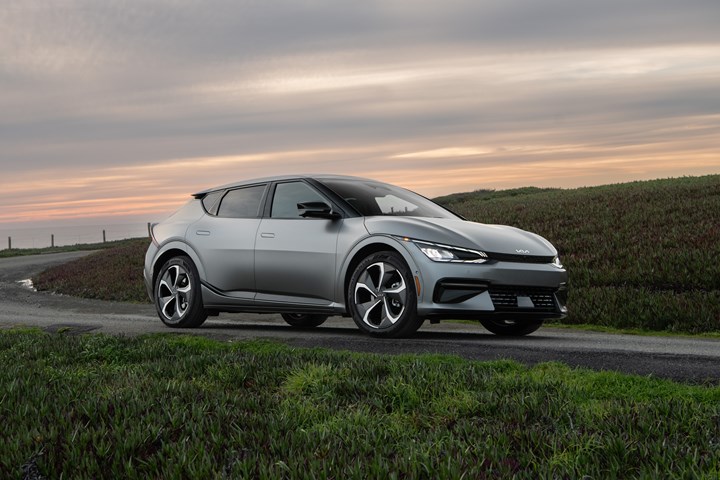
Looks like the future. Drives like it, too. (Image: Kia)
Here’s something that you probably don’t know about the handsome and capable Kia EV6:
It is the first Korean car to achieve product carbon footprint certification from the Carbon Trust.
Which is to say there is third-party validation of the green credibility of this electric vehicle.
These standards were applied:
- PAS 2050:11, an internationally recognized specification for life-cycle greenhouse gas emissions
- Greenhouse Gas Protocol, which is a product life cycle accounting and reporting standard
- ISO 14067 (2013), which relates to the carbon footprint of vehicles in terms of quantification and communication
Said Sangdae Kim, Head of Strategic Business Planning Division at Kia:
“This is important validation of a broad range of measures we are now taking to reduce the carbon footprint of a vehicle throughout its lifecycle. As we introduce more electrified models to our line up over the coming years, we will step up our sustainability efforts and ensure we are achieving high levels of transparency when it comes to environmental impact.”
What Matters
Does it matter that Kia consciously considered the environmental ramifications of everything from the acquisition of raw materials to the procurement of parts to the transportation of parts to vehicle assembly, distribution, use, to end-of-life recycling?
Does it matter that there are tangible things like the use of recycled plastics so that in a given EV6 there is the equivalence of 107 half-liter PET soda bottles?
It should. Because the proliferation of electric vehicles shouldn’t simply be considered as cool replacements for vehicles that run on gasoline. (Not that they aren’t. In some cases. Like this.)
Part of the rationale—to say nothing of the regulations—behind the development and production of EVs is to reduce the carbon emissions related to transportation.
So Kia is paying attention to the impact that the EV6—as well as the more than a dozen EVs it is planning to offer by 2026—has on the environment.
Car Stuff
Of course, when you buy a vehicle, you’re looking for more than a sticker of good global citizenship.
So know. . .
The wheelbase is 114.2 inches and the length is 184.3 inches. The width is 74 inches and the height 60.8 inches.
To add some color to those figures, Kia points out that the wheelbase is that of its midsize Telluride SUV.
It offers 103 cubic feet of passenger room and 24.4 cubic feet of cargo behind the second row and 50.2 with the seat folded. Roomy for people. Roomy for stuff.
The AWD version driven here has 320 hp and can go really quick (e.g., 0 to 60 mph in ~4.6 seconds).
Charge
It has a 77.4-kWh lithium-ion polymer battery. The all-important range is 274 miles (although that will not be the case if you spend a lot of time going 0 to 60).
If you get to a 350-kW DC fast charger, you can charge the battery from 10% to 80% in about 18 minutes.
The EV6 has a pair of 12.3-inch TFT screens that flow across the IP and provide everything from the speedo to infotainment. (The screen(s) execution is exceedingly well done: it doesn’t look forced as is sometimes the case in vehicles that want to flaunt their tech prowess.) The available head-up display is interesting in that rather than having the information on the lower part of the windshield as is typically the case, it appears to be on the hood of the vehicle. (Speaking of which: No frunk.)
Know This
Which brings me back to the beginning.
Kia was as serious about developing the EV6 right as they were about the vehicle as desirable consumer product.
Can’t get much better than that.
>>>
Rice Waste to Tires

Sodium silicate can be derived from rice husk ash, which can then be used for motor vehicle tire production. (Image: Evonik)
One of the materials used in the production of tires engineered for fuel efficiency is silica. So if these tires are being offered as being more environmentally benign (i.e., as improving fuel efficiency up to 8% compared to other passenger vehicle tires), then it probably isn’t a bad thing for their production to be greener, as well.
Evonik, which is one of the leading suppliers of silica, is addressing this aspect:
“For the first time, we can offer our customers an ULTRASIL silica with an improved sustainability profile, thus we can support our customers' carbon reduction and circularity goals.”—Emmanuel Auer, Head of Silica business line.
The Network
The key raw material for the sustainable silica is sodium silicate. An Austrian company, the Pörner Group, has developed a patented process to produce sodium silicate from rice husk ash, an agricultural waste product. Evonik has entered into a strategic cooperation agreement with the company.
Evonik has also entered into an agreement with Phichit Bio Power Co., Ltd., of Thailand, which has rice mills and biomass power plants. It licenses Pörner Group’s technology.
What Does This Mean?
A reduced CO2 footprint of 30% compared with Evonik’s standard silica.
Green Jobs
There is another benefit, as well.
Notes Banjong Tangjitwattanakul, President of Phichit Bio Power:
“The environmental benefits of producing silicate from rice husk ash are clear, but equally as important are the benefits the cooperation brings for our stakeholders in the region. For example, through the creation of new jobs for local communities around the plant, or for farmers who will be able to connect to our electricity generation network.”
>>>
Some Quick. One Calm
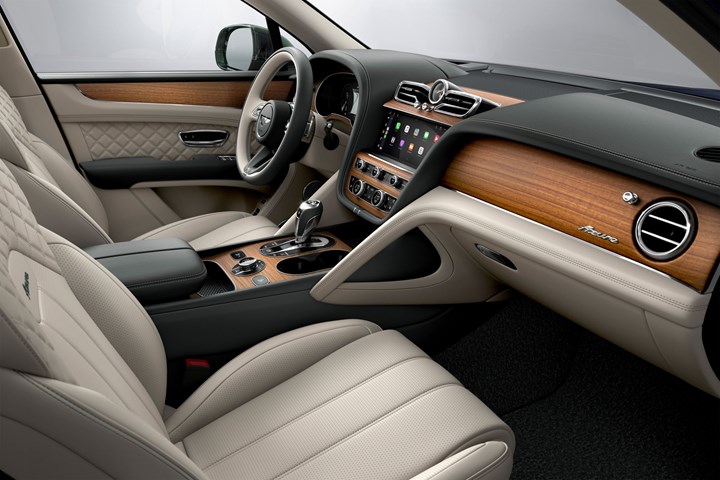
Inside the Bentayga Azure Hybrid. Feel relaxed? (Image: Bentley)
Last week BMW announced a new hybrid vehicle, the BMW XM, an SUV.
The plug-in hybrid powertrain consists of a 4.4-liter turbocharged V8 that produces 483 hp and a 194-hp electric motor that’s integrated into the eight-speed M Steptronic transmission.
All of which is to say is that the system horsepower is 644 and it produces 590 lb-ft of torque.
The $159,000 vehicle is said to have a 0 to 60 mph time of 4.1 seconds. Which is impressive for a large (201.2/78.9/69.1-inch length/width/height) SUV. . . that happens to have a curb weight of 6,062 pounds.
(If this isn’t impressive enough, know that after launch at the plant in Spartanburg, SC, BMW will bring out the BMW XM Label Red: it will have 735 hp and 735 lb-ft of torque.)
And More
It was a big week for luxury hybrid SUVs because Bentley added the Bentayga S Hybrid and the Bentayga Azure Hybrid models to its lineup.
Of course, the S is a performance model that combines a 3.0-liter V6 with a 100 kW electric motor-generator to provide a combined 450 hp. There is also trim that underscores this is meant to be discerned as the fast model.
Just Breathe
What is more interesting is the Azure.
This vehicle is predicated on providing a serene surrounding.
Bentley cites research that indicates “those exposed to traffic noise over 70 decibels were 65 percent more at risk of depression.”
So they worked to make things quiet on the interior.
The Bentley development team collaborated with “creative neuroscientist” Katherine Templar-Lewis to determine how to achieve “wellbeing behind the wheel.”
Sounds. Colors. Textures.
There is a 22-way adjustable seat that is heated and cooled “to maintain the body’s optimum temperature for comfort and alertness.”
Bentley has long been known for its quilted seats.
In the Azure it is “wellness quilting.”
The available open-pore veneers are said to “offer a calm, stain sheen as alternatives. . . to high gloss veneers.”
The work by the Bentley team and Templar-Lewis on the Azure provided a “science-based analysis to the relaxing experience of traveling in a Bentley, as a driver or passenger.”
Will calm become the new quick?
>>>
Four Things About Gas/Recharging Stations
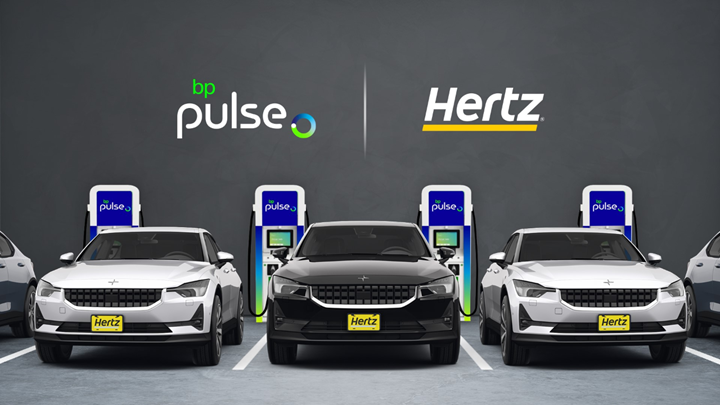
Hertz and bp signed an agreement that will have the build-out of a national EV charging station network for Hertz customers as well as the general public. (Image: bp)
Dover Fueling Solutions, which provides both gas pumps and EV chargers, conducted a survey to gauge issues related to what’s occurring today at gas stations and what could be the case with the transition to EVs.
Which has some interesting results.
- Having to deal with a credit card company is an experience, too. Not a good one. Consumers want gas pumps that don’t have card skimmers more than “experiential offerings such as loyalty programs or. . .fast payments and touch-screen terminals.” Getting points for free coffee isn’t as appealing as not getting one’s credit card ripped off.
- Paying more for less? Only 20% of those refueling at a gas station think they are “always” getting the amount of fuel they are paying for. For Millennials the number saying “always” is 10%--but 16% say “never.” Imagine going to a fast-food burger place, ordering five burgers and finding four in the bag.
- Everyone talks about infrastructure. But station owners need to pay for it. With gasoline sales, the station owners “know how much margin they make on every gallon and how many vehicles they can expect to fuel.” That’s not the case with EVs. So it may be that they need to offer other items to increase profit margins. And here’s something important regarding the infrastructure build out: it can take as long as 24 months to get an EV permit, so gas station owners need to think ahead and not just about what flavors of beef jerky to stock.
- What to do while waiting. Overall, 39% want a coffee shop. 29% want a sit-down restaurant. 11% want a place to work. Generationally, 20% of Boomers want a dog park and 22% of Gen Z want a dry cleaner. Hard to discern which is an odder choice.
///
RELATED CONTENT
-
Toyota Employees to Aid Michigan V2X Research
Toyota Motor Corp. is encouraging employees at its research and development center near Ann Arbor, Mich., to participate in an on-going program there to test connected vehicle technologies.
-
On The Jeep Grand Cherokee, 2022 Nissan Pathfinder, and More
An inside look at the Detroit Assembly Complex-Mack; a innovative approach to waste-free, two-tone painting; why a forging press is like an F1 car; and other automotive developments.
-
ZF in the Oasis
What you’re looking at is the “Intelligent Rolling Chassis” ZF has developed for the Rinspeed Oasis, a concept vehicle.


.jpg;width=70;height=70;mode=crop)






